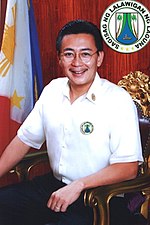Search results
Appearance
There is a page named "Calauan" on Wikipedia
- Calauan (IPA: [kɐˈlaː.wɐn]), officially the Municipality of Calauan (Tagalog: Bayan ng Calauan), is a municipality in the province of Laguna, Philippines...19 KB (1,234 words) - 00:11, 25 January 2025
- footwear from Liliw, the Pandan Festival of Luisiana, the Pinya Festival of Calauan, the Seven Lakes of San Pablo, and the Nagcarlan Underground Cemetery in...127 KB (10,427 words) - 16:16, 30 March 2025
- 1946 – March 27, 2021) was a Filipino politician who served as mayor of Calauan, Laguna from 1980 to 1986 and from 1988 to 1993. He is the convicted mastermind...14 KB (1,253 words) - 00:48, 27 February 2025
- June 28, 1993 in Calauan, Laguna, Philippines. The case involved police personnel and the late Antonio Sanchez, the former mayor of Calauan, who were tried...38 KB (3,778 words) - 21:08, 4 April 2025
- and western Laguna municipalities of Alaminos, Bay, Cabuyao, Calamba, Calauan, Los Baños, Pila, and Victoria until 1972; Biñan until 2016; and Santa...36 KB (429 words) - 01:16, 5 April 2025
- University of the Philippines, Calauan Laguna Campus or PUP Calauan (Filipino: Politeknikong Unibersidad ng Pilipinas, sa Calauan) is a PUP campus located in...3 KB (172 words) - 20:01, 8 November 2024
- 2025 Laguna local elections (section Calauan)for running for reelection. City: San Pablo Municipalities: Alaminos, Calauan, Liliw. Nagcarlan, Rizal, Victoria Incumbent Alejandro Yu is term-limited...97 KB (1,713 words) - 10:59, 8 April 2025
- 2022 Laguna local elections (section Calauan)Municipalities: Bay, Los Baños City: San Pablo City Municipalities: Alaminos, Calauan, Liliw. Nagcarlan, Rizal, Victoria Municipalities: Cavinti, Famy, Kalayaan...88 KB (981 words) - 14:25, 25 January 2025
- The Bay–Calauan–San Pablo Road is a national primary road that connects the municipality of Bay to the city of San Pablo. It is also known as Mariano...3 KB (113 words) - 13:36, 15 July 2024
- 2013 Laguna local elections (section Calauan)certificate of candidacies. Cities: San Pablo City Municipality: Alaminos, Calauan, Liliw. Nagcarlan, Rizal, Victoria Parties are as stated in their certificate...66 KB (687 words) - 09:16, 12 February 2025
- 2010 Laguna local elections (section Calauan)certificate of candidacies. Cities: San Pablo Municipality: Alaminos, Calauan, Liliw, Nagcarlan, Rizal, Victoria Population (2007): 470,972 Parties are...51 KB (539 words) - 03:41, 7 February 2025
- 2007 Laguna local elections (section Calauan)Municipality: Bay, Cabuyao, Los Baños Cities: San Pablo Municipality: Alaminos, Calauan, Liliw, Nagcarlan, Rizal, Victoria Municipalities: Cavinti, Famy, Kalayaan...75 KB (501 words) - 08:02, 21 March 2025
- District Rep. Loreto "Amben" S. Amante, Liliw Mayor Ildefonso Monleon, and Calauan Mayor Roseller Caratihan in a simple ceremony at the House of Representatives...14 KB (975 words) - 01:51, 9 February 2025
- consists of the city of San Pablo and adjacent municipalities of Alaminos, Calauan, Liliw, Nagcarlan, Rizal and Victoria bordering Batangas and Quezon also...24 KB (220 words) - 06:37, 2 January 2025
- 2016 Laguna local elections (section Calauan)Municipality: Bay, Los Baños Cities: San Pablo City Municipality: Alaminos, Calauan, Liliw. Nagcarlan, Rizal, Victoria Municipalities: Cavinti, Famy, Kalayaan...66 KB (986 words) - 10:18, 11 March 2025
- Lipa. The nearest municipalities are Liliw, Rizal, Majayjay, Magdalena, Calauan, and Luisiana. Its distance from the national capital is 68.58 kilometers...26 KB (1,991 words) - 04:10, 14 March 2025
- down the March 1995 verdict against former Calauan, Laguna mayor Antonio Sanchez and six others (then-PNP Calauan Deputy Chief George Medialdea, Luis Corcolon...7 KB (570 words) - 09:06, 13 March 2025
- present, with the oldest being sediment-filled, like the ones found in Calauan. The youngest maars contain deep lakes with many concentrated in the city...8 KB (1,287 words) - 18:52, 8 December 2024
- Mount Buboy, Calauan 14°05′47.0″N 121°14′36.9″E / 14.096389°N 121.243583°E / 14.096389; 121.243583 (Mt. Buboy) Mount Bulalo, Calauan 14°6′4.5″N 121°13′34...17 KB (1,803 words) - 23:53, 21 March 2025
- Population (2020): 1,077,536 Cities: San Pablo City Municipalities: Alaminos, Calauan, Liliw, Nagcarlan, Rizal, Victoria Population (2020): 590,757 Notes: Elevated...27 KB (450 words) - 01:34, 14 March 2025
- English Wikipedia has an article on: Calauan Wikipedia Calauan A city in Laguna, Philippines Meronyms: Balayhangin, Bangyas, Dayap, Hanggan, Imok, Kanluran
- armies that remain. We will not allow any more criminal brotherhoods, as in Calauan, to exist. This includes purging local police forces of scalawags and bullies















